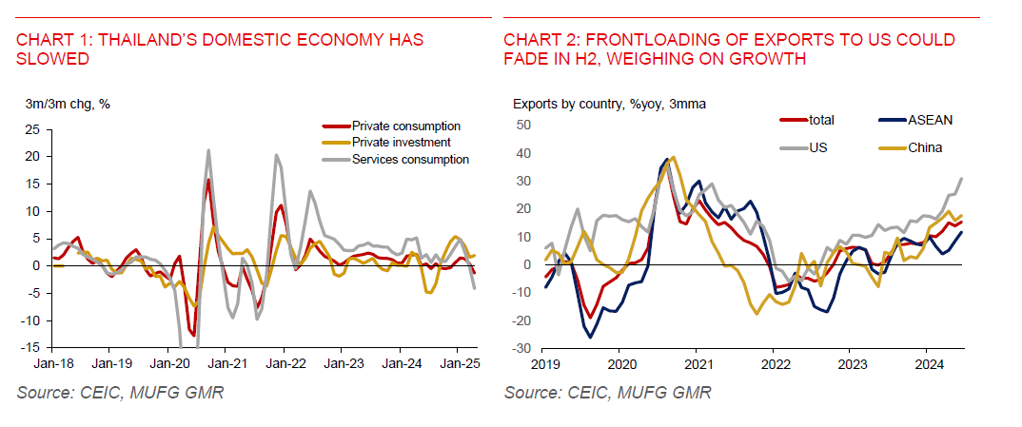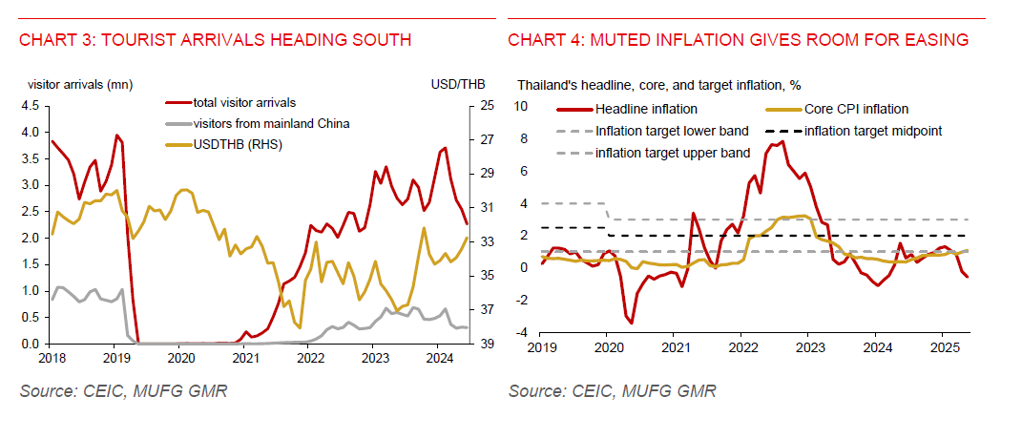Key Points
Please click on download PDF above for full report
- The Bank of Thailand left its benchmark policy rate unchanged at 1.75%, in line with our expectations as the central bank seeks to preserve policy space following rate cuts in the past 2 meetings. The MPC voted 6-1 in favour of the rate hold, with one MPC member advocating for a 25bps rate cut. Despite the rate pause, a dovish tone was maintained, with the MPC noting that monetary policy should stay accommodative to support growth in H2.
- The Thai baht showed limited reaction to the policy rate decision, given markets have largely priced that in. Looking ahead, we maintain our outlook for the Thai baht to weaken modestly against the US dollar. This will mainly be driven by a slowdown in Thailand’ GDP growth in H2 and weaker tourism receipts. We are also of the view that market sentiment on USDTHB has been notably weak, suggesting scope for a potential reversal.
- While Thailand’s economic growth in H1 was more resilient than expected, it is likely to slow meaningfully in H2. We forecast Thailand’s real GDP growth to slow to just 1.6%yoy in H2, down from an estimated 2.9%yoy in H1. This brings our outlook for 2025 growth to 2.2%, slightly below the BoT’s forecast of 2.3%. We expect the frontloading of goods exports that supported H1 growth to fade away, while US tariff headwinds will begin to weigh on trade. Tourist arrivals have also softened to 14.4mn in the first five months of 2025, down from 14.8mn over same period in 2024. With the peak tourism season now over, lower tourism receipts are likely to weigh on economic growth, with the Thai baht entering a period of seasonal weakness.
- Given the backdrop of slowing domestic growth and negative inflation, we maintain our outlook for the BoT to cut rates by another 25bps to 1.50% in the August meeting. Notably, headline inflation turned negative in April and May. While core inflation inched up to 1.1%yoy in May, from 1%yoy in April, this was still muted and stayed at the lower bound of BoT’s 1%-3% inflation target range. While the Fed is expected to resume policy easing in H2, we believe Thailand’s growth slowdown will outweigh the impact of a narrowing US-Thailand yield differential. As such, we forecast USDTHB to rise towards 33.50-level by end-2025, up from around 32.60 at the time of writing.
- The risk of a much sharper THB depreciation and more BoT rate cuts than we currently expect could stem from several factors. These factors include the potential implementation of the full 36% US reciprocal tariffs, a renewed escalation of Israel-Iran conflict that could raise oil prices sharply, or a collapse in the Pheu Thai-led coalition government. For now, we assume these risks are contained. On trade, the Thai government continues to engage with the US to secure more favourable trade terms, and the full 36% reciprocal tariff appears to represent the upper ceiling. Actual US tariff rate on Thailand will likely be lower. The Israel-Iran ceasefire has also led to a retracement in oil prices, reducing the risk of an oil price shock. On politics, the withdrawal of the conservative Bhumjaithai party – the largest coalition partner with 69 parliamentary seats – has raised political uncertainty. But for now the Pheu-Thai led coalition government still has a slim majority in parliament and markets have not priced in a significant political risk premium.



